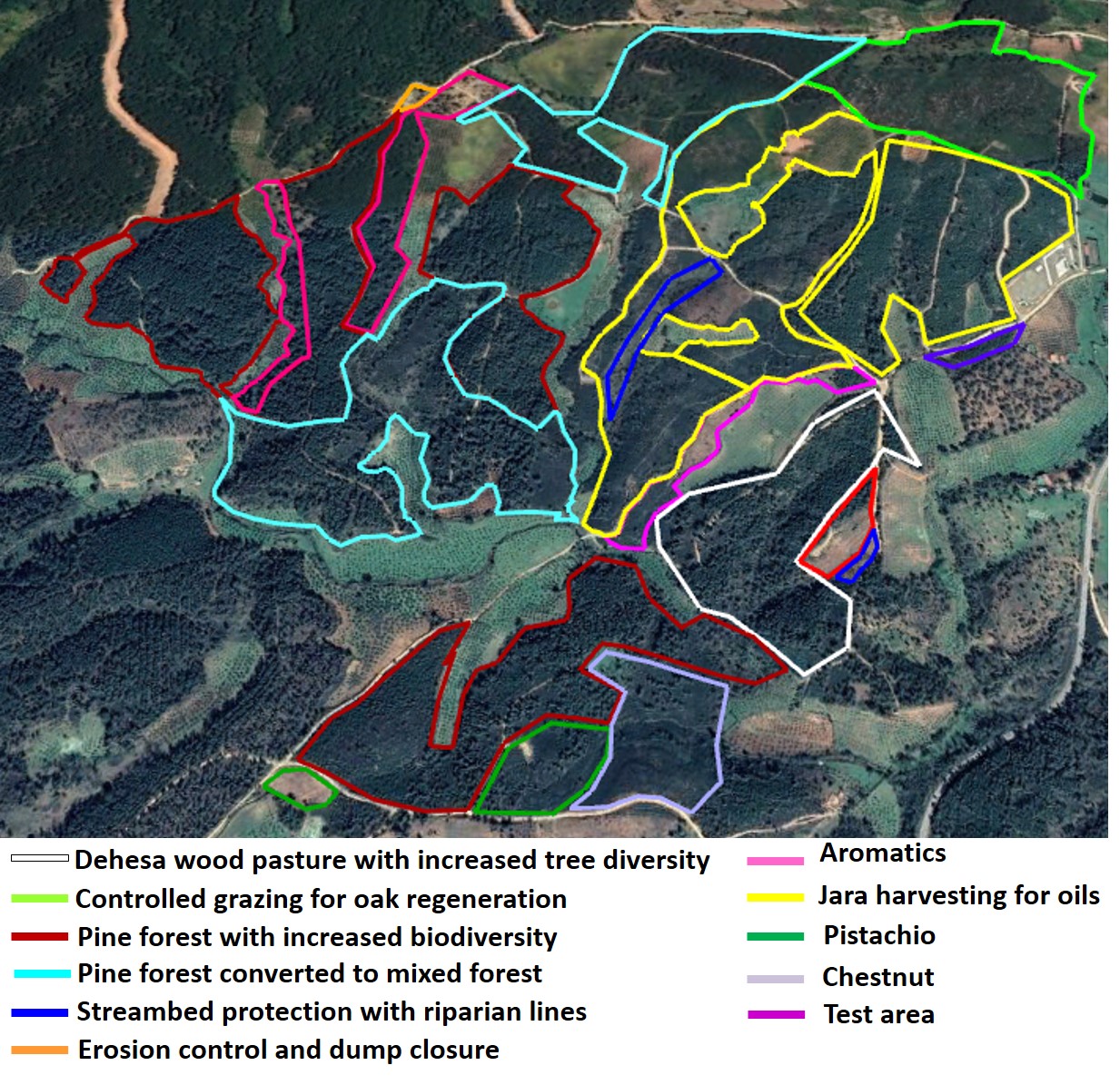|
L6 VdFres - Ayuntamiento de Valverde del Fresno (SP) |
|||||
|
|
|||||
|
FUNCTIONS APPLIED TO THE LAND |
|||||
|
ECONOMIC |
|||||
|
Oak nuts and cork [15, 13] |
Conversion of closed forest to open woodland with increased tree diversity of edible species. Main operations are partial shrub removal to increase grass availability and reduce competition with wild fruiting species. |
||||
|
Pine forest with increased biodiversity [19] |
Promotion of tree and shrub diversity with species other than pine as well as making wildlife shelters for birds, bats and rabbits. |
||||
|
Pine forest converted to mixed forest [19] |
Enhancing growth of existing juvenile trees of broad leaves species (oaks, madroño, wild pear) to end with a mixed forest. Main operations are plant competitor release and pruning of lateral branches to increase vertical growth. |
||||
|
Aromatics [1] |
Planting of native and drought-tolerant Lavandula luiseri with little impact on soil structure. Future oil production will be harvested by local farmers. This plantation is also very beneficial to pollinators. |
||||
|
Jara harvesting for oils [16] |
Cutting of young shoots producing oils in summer in large areas to reduce fire risk while increasing production for local farmers. Action linked to research program on jara processing (oils and biomass). |
||||
|
Pistachio [15] |
Small experimental plantation of wild pistachio that later need to be grafted with commercial varieties by local farmers. |
||||
|
Chestnut [15] |
Plantation of chestnut trees that later will be grafted by local farmers to obtain fruits for market. Large area acting as fuel breaks between closed forests patches. |
||||
|
Bee keeping [11] |
Already doing. Working with one bee keeper for marketing of honey and pollen. |
||||
|
ECOSERVICES |
|||||
|
Test area [32] |
Plantation of native palatable tree species to be used as food supplement for goats and sheep. | ||||
|
Bee keeping rights [22] |
|||||
|
Hiking trails [27] |
|||||
|
Study & Research Facilities. [34] |
4 year research on jara oils. | ||||
|
Game hunting [36] |
Building of houses for rabbits. | ||||
|
ENVIRONMENTAL |
|||||
|
Controlled grazing for oak regeneration [41, 4] |
Regulation of sheep and goat grazing to control shrubs and allow tree growth through pruning. | ||||
|
Erosion control and dump closure [37, 44] |
Removal of all kinds of non-natural remains in the old dump, prohibition of rubbish drop and signalling, and maintenance of lines of shrubs to avoid soil erosion. | ||||
|
Streambed protection with riparian lines [42, 43, 46] |
Planting of riparian trees along streams in deep soils and protected with wire shelters. | ||||
|
Wildlife protection [39] |
Stone hills for rabbits, maters, foxes. Nest boxes will be also added. | ||||
|
Insect shelter [40] |
Bird houses. See wildlife protection. | ||||
|
SOCIAL |
|||||
|
Create employment [47] |
Municipality workers involved through the project plus support to bee keeper and organic aromatics. | ||||
|
Work with disabled people. [48] |
|||||
|
Provide social services [49] |
Working with schools. | ||||
| MEASURES APPLIED TO THE LAND | |||||
| N. | Name | Comments | |||
| 1 | Seed collecting |
Almost all plants come from local seed sources. |
|||
| 3 | Existing vegetation |
Low density shrub areas have been removed in order to plant aromatics and nuts, thus creating small firebreaks. |
|||
| 4 | Mycorrhizae & plants | ||||
| 9 | Half-moons | Used on the slopes. | |||
| 10 | Soil ripping | ||||
| 11 | Conservation Tillage | Used in aromatic and pistachio plots. | |||
| 13 | Capture & Store Water | ||||
| 14 | Organic fertilizer | ||||
| 21 | Plant hole digging | ||||
| 22 | Interplanting | ||||
| 23 | Planting in mixes | ||||
| 24 | Regular planting | ||||
| 27 | Watering/Drip irrigation |
Tank delivering water on individual trees. |
|||
| 28 | Plant protectors | ||||
| 29 | Plant assist | ||||
| 30 | Fencing installation | ||||
| 31 | Grafting trees | Pistachio and chestnut trees | |||
| 33 | Weed control | ||||
| 37 | Livestock Grazing | No plan, but regulation to avoid plant damage. | |||
| 38 | Ecoservices | ||||
| 44 | Firewood 10% rule | Dead wood left intact. | |||
| 45 | Natural Regeneration | ||||
| 51 | Planting material | ||||
|
Numbers of functions and measures correspond to the list reported in the DAM methodology, defining the operative DAM plan http://www.desert-adapt.it/index.php/en/case-studies/dam-methodology |
|||||
| FIELD IMPLEMENTATION OF THE DAM PLAN | |||||
|
Chestnut and pistachio production and testing plant growth aid techniques to support seedlings establishment and growth [Economic function: Nuts 15; Adaptation Measures: plant support & water aid 26 - plant protectors 28 - plant assist 29] In Valverde del Fresno plant supports that improve the seedling survival rates in the first years after planting under harsh environmental conditions, were tested, as part of the project objectives. The plant water aid “Cocoon” was tested. (https://www.youtube.com/watch?v=sll6IO65vPg) (Pict. 1), together with mulching with local chipped wood and full-moons (Pict. 2). Plastic tube and metals protectors (cactus) were installed in several plots to protect seedling (Pict.3-9). |
|||||
|
|||||
|
Jara harvesting for oil production [Economic function: Oil 16 - Aromatics 1] As part of its new land management plan, the Municipality of Valverde del Fresno found a sustainable way to manage the rockrose (Cistus ladanifer, locally "jara"), one of the most significant natural shrubs in the Mediterranean basin. This plant shows high proliferation, occupying abandoned agricultural areas of Montado and Dehesa, and may represent a fire hazard. Rockrose is used in cosmetic and perfume industries as a source of resin (labdanum gum) and essential oils. The measure introduced by Municipality is to harvest the plant (Pict 1-10) and use it for the production of essential oils rather than to destroy its biomass and disturb the soil as traditionally done. Picture 11 shows the extraction procedures teste at the University of Extremadura. This measure can benefit both local communities with creation of jobs and landowners with new income opportunities, while providing a way to reduce fire risk and ecosystem degradation. Native and drought-tolerant Lavandula luiseri was also planted for future oil production starting from the seed of wild species (Pict. 12-13). |
|||||
|
|
|||||
| |
|||||
|
Actions to improve environmental services [Economic functions: bee keeping 11; Environmental functions: erosion control 37 - wildlife protection 39 – Insect shelters 40 - waste control 44 – reforestation 41] In Valverde, the permanent production of aromatic plants contributes to the improvement many ecosystem services such as erosion control and pollination, indeed beehives were installed for the marketing of honey and pollen (Pict. 1). Additionally, wildlife is also protected and improved creating houses and refuges for animals (Pict. 2-3) with local materials. Soil erosion is reduced adopting different approaches: i) regulating grazing to allow shrubs and tree growth and regeneration (Pict. 4) and ii) maintaining lines of shrubs (Pict. 5-6) in steep old dump previously cleaned of all kinds of non-natural wastes (Pict.7). |
|||||
|
|
|||||
| |
|||||







